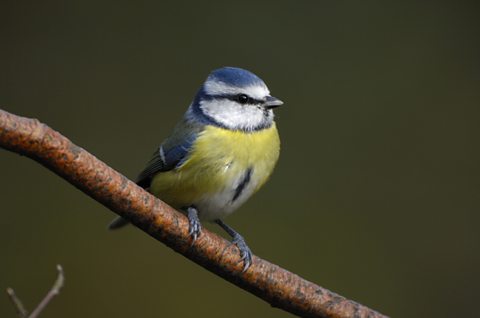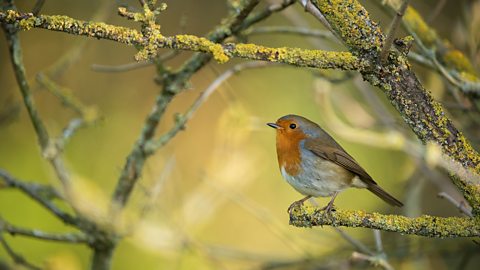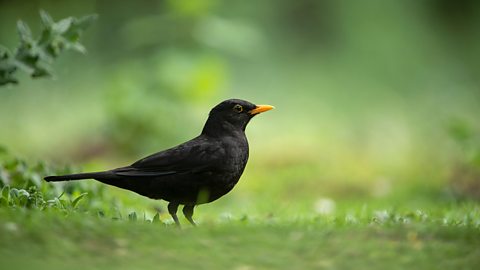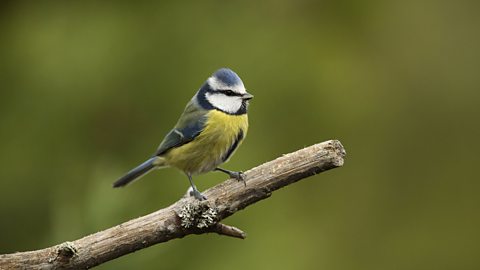 Image source, RSPB
Image source, RSPBThe start of 2021 has been a challenging time for parents, teachers and children alike. Whilst travelling outside your local area might be difficult at present, the simple act of birdwatching could help children – both at home and in school – get outside for some fresh air.
It could even provide an unexpected opportunity for learning.
We spoke to the RSPB, who run the annual Big Schools Birdwatch, to find out about some of the birds you and your children might see in your garden, local park or school playground, how these bird populations have changed over the years, and how you might be able to encourage them into your open spaces.
 Image source, RSPB
Image source, RSPBHouse sparrows
 Image source, RSPB
Image source, RSPBHouse sparrows are among the most commonly sighted birds in the UK. They are noisy and gregarious and can thrive in urban environments near to people but also live happily in the countryside. They are found in most parts of the world and there are more than 5 million breeding pairs in the UK.
However, monitoring suggests there has been a severe decline in the UK's house sparrow population in the past 50 years or so. Recent figures estimate that the number of house sparrows fell by 71 per cent between 1977 and 2008 with substantial declines in both rural and urban populations. But while the decline in England continues, Breeding Bird Survey data indicate population increases in Scotland, Wales and Northern Ireland.
Exactly what is behind the decline is not clear, but we know that house sparrows thrive on household scraps and will take advantage of food and wildlife-friendly features we create for them in playgrounds and gardens.
If you want to encourage house sparrows into your garden or playground, you can create a bird feeding area. Their favourite foods are berries, peanuts, household scraps like bits of fatty meat and small seeds like millet or nyjer seeds. House sparrows will nest near people, usually in building crevices but nest boxes will also encourage sparrows into your space.
Blue tits
 Image source, RSPB
Image source, RSPBBlue tits are one of the most attractive and easily recognised birds you can see in the garden, park or playground, with their colourful mix of blue, yellow, white and green feathers. They are most often seen in winter, when whole families come together to search for food.
Blue tits, like other small birds like great tits, have seen an increase in their numbers in the UK, and there are an estimated 15 million birds in the country. The recent pattern of milder winters may have helped their numbers as more birds survive through the winter. However, one harsh winter can mean their numbers decrease due to lack of food, leading to a poor breeding season.
Blue tits will hunt for food in gardens and playgrounds, searching in crevices and plants for insects, berries and seeds. They will also take advantage of bird feeders and food put out for them, especially high energy seeds like sunflower hearts, suet food bars or peanuts. You can watch them as they hang upside down from bird feeders. They will benefit from nest boxes to build their nests but are also known to use them to shelter during cold, harsh winter nights. If you want to encourage blue tits to your open space, it’s best to choose a nesting box with a smaller entrance so they can’t be pushed out by larger birds.
 Image source, RSPB
Image source, RSPBRobins
 Image source, RSPB
Image source, RSPBWith its easily-recognisable bright red breast, the robin is found across the UK in woodland, hedgerows, parks and gardens. Robins are aggressively territorial and are quick to chase away other birds who intrude on their territory, especially in winter when food is scarce. This is why you’ll usually see robins on their own.
In the past 50 years, the robin population in the UK has increased by 45 per cent. However, mortality is high amongst robins and only around 40 per cent of fledged birds survive from one year to the next. This high level of mortality is compensated by a high birth rate, but a severe winter weather can see a decline in their numbers. A bird can use up to 10 per cent of its body weight during one cold winter night, and unless it can feed well every day to replenish its reserves, a prolonged cold spell can be fatal.
Robins mainly eat insects and worms but, in the harsh winter months, bird tables can make a big difference to their survival. Their favourite bird table treat is mealworms, but they will also enjoy kitchen scraps: fat, cheese, cake and biscuit crumbs. They usually nest in trees and walls but may use a nesting box if one is available.
Blackbirds
 Image source, RSPB
Image source, RSPBThe blackbird is king of the playground, with a huge 85 percent of schools reporting seeing at least one blackbird in their grounds during the Big Schools’ Birdwatch birds in 2020. Blackbirds are found all over the UK in gardens and countryside and from coasts to hills. The male blackbird lives up to its name with its black, glossy feathers and bright orange beak, but confusingly, females are brown, often with spots and streaks on their breast.
Blackbird populations have remained stable in recent years with an estimated population of 10 to 15 million birds. However, food availability is often a problem, causing chicks to starve, particularly in dry weather.
Blackbirds mainly feed on plants, fruit and insects, often from the ground. They can be seen searching through garden lawns or leaf litter for food. You can help blackbirds by planting fruit trees and shrubs that produce berries and where insects can thrive. If you want to leave out food for them, they will feed off fruit and kitchen scraps from the ground or from a ground table. You can also think about leaving out fresh, clean water as all birds need it for drinking and bathing. In winter natural supplies of water can freeze while in summer they may dry out.
 Image source, RSPB
Image source, RSPBBlack-headed gulls
 Image source, RSPB
Image source, RSPBDespite its name, the black-headed gull doesn’t actually have a black head. Its head is chocolate brown in summer, but for most of the year its head is white. It's the commonest inland gull in the UK with an estimated population of over two million birds. Black-headed gulls are sociable, quarrelsome and noisy, and are usually seen in small groups or flocks. They gather together where food is plentiful, or when they're roosting.
Open areas like school playing fields are rich feeding areas for black-headed gulls, as the short grass is ideal for birds to find natural food supplies like insects and worms. Over the last 20 years, the Big Schools’ Birdwatch data shows that black-headed gull numbers in school grounds have increased by 94 percent. Nonetheless, their numbers overall have declined in recent years.
The black-headed gull is successful at adapting to man-made changes in the environment and will scavenge on household and industrial waste, as well as on small fish and small carrion like mice and rats. In some areas steps are taken to control numbers of black-headed gulls as they harass and predate higher risk species and will often steal food from other birds.
The Big Schools Winterwatch Live Lesson
ґуПуґ«ГЅ Teach has partnered with Winterwatch and the RSPB for a very special Live Lesson on 28th January, to help children learn key skills to help them get outdoors and find out more about the birds in their environment. It’s available to watch from home or school and you can find out more here.
28 January: The Big Schools Winterwatch Live Lesson
Gather up, Winterwatchers! Take flight with a cross-curricular Live Lesson in partnership with Winterwatch and the RSPB.

Safer Internet Day - Live Lesson. video
In this Live Lesson in partnership with the UK Safer Internet Centre, aimed at primary-aged students and linked to the primary computing curriculum, we learn about how we can stay safe, responsible and wise in an increasingly digital world, with tips and advice from some of the biggest personalities on the web.

Getting the best out of Live Lessons
Teacher Ryan Smith shares his top tips for getting the best out of our Live Lessons.
